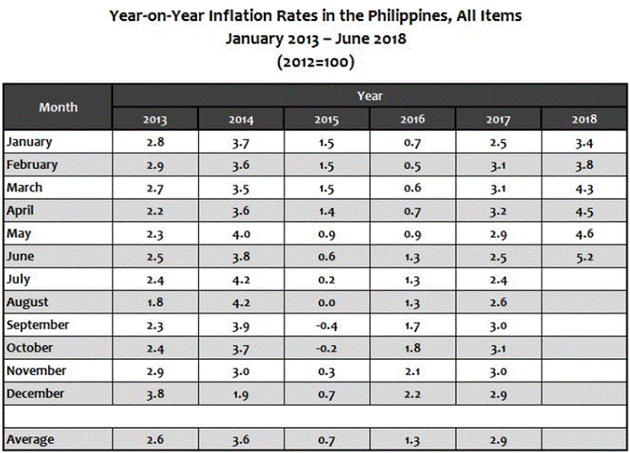
Photo/VCG
July 13 (NBD) -- "When warranted, the BSP stands ready to provide liquidity and ensure that legitimate demands for foreign currency are satisfied," Bangko Sentral ng Pilipinas (BSP) said to NBD in an exclusive interview concerning sliding peso and rising inflation.
Data released from the BSP show foreign portfolio investments remained in negative territory in June, recording a net outflow of 516 million U.S. dollars, more than twice the 206-million-U.S. dollar net outflow posted in May this year.
The BSP attributed this to the United States Federal Reserve’s decision to increase interest rates and investor concerns on inflation and the further weakening of the Philippine peso, Business World reported citing the BSP's statetement, but the bank reiterated that the Philippine growth remained underpinned by solid economic fundamentals in the interview with NBD.
The BSP to provide liquidity when warranted
The Philippine peso is hovering at 12-year lows and the headline inflation for the Philippines further increased by 5.2 percent in June 2018.
According to data from the Philippine Statistics Authority, faster annual increments were registered in the indices of Alcoholic Beverages and Tobacco (20.8 percent); Housing, Water, Electricity, Gas, and Other Fuels (4.6 percent); Furnishing, Household Equipment and Routine Maintenance of the House (3.0 percent); Transport (7.1 percent); Communication (0.4 percent); and Education (4.0 percent).

Source:the Philippine Statistics Authority
Geopolitical instability in Middle East area, climbing world's oil price and a weaker peso against U.S. dollar have been piling pressure on Philippine domestic fuel price. Asked how the BSP would take action against peso slump and investor exodus, the Philippine central bank elaborated that the decision to raise the policy interest rate on June 20 of 2018 was intended mainly as a follow-through action to address the BSP's concerns on inflation expectations for 2018 as well as the risk of possible second-round effects from ongoing price pressures.
By second-round effects, it refers to the reactions of market participants to first-round effects, for example, to a specific earlier increase/decrease in the prices of individual goods or services.
The BSP also underlined that responses to excessive exchange rate volatility need not be confined to interest rate action, since the central bank has various tools at its disposal to ensure orderly foreign exchange market conditions, including participation in the FX spot market and moral suasion. The BSP stands ready to provide liquidity and ensure that legitimate demands for foreign currency are satisfied by using tools including participation in the foreign exchange market, monetary policy measures as well as foreign exchange regulations, the bank said to NBD.
The country's economic fundamentals remain sound, says the BSP
According to data compiled by Bloomberg, as of June 17, 2018, investors have pulled out 19 billion U.S. dollars from the Philippines, Indonesia, India, South Korea, Thailand and China's Taiwan so far this year, at the fastest pace since the global financial crisis of 2008.
"We note that the information from Bloomberg mainly pertains to stock market data. Looking at investor activity from a bigger picture, i.e., to include apart from stock market figures, other forms of equity placements, we see foreign investment flows have remained resilient so far this year, especially as far as the Philippines is concerned," the BSP explained to NBD.
The BPS highlighted the country's performance in terms of foreign direct investments (FDIs) which registered net inflows of 2.2 billion U.S. dollars in Q1 2018, an increase of 43.5 percent from 1.5 billion U.S. dollars in the comparable period last year. "In particular, net equity capital increased more than six-fold to 887 million U.S. dollars, and bulk of said placements were invested in manufacturing; financial and insurance; real estate; arts, entertainment and recreation; and utilities," the bank added.
Moreover, as of June 1 this year, BSP-registered FPI transactions yielded overall net inflows of 797 million U.S. dollars, a reversal from the net outflows recorded for the same period in 2017 of 543.8 million U.S. dollars.
"These sustained foreign exchange inflows reflect the continued strength of the Philippine growth narrative, which remains underpinned by solid economic fundamentals,” the BSP said, adding that such favorable economic fundamentals constitute the advantage that the Philippines has against this economic turbulence sweeping emerging countries.
The Philippine central bank also expressed its confidence in the country's economy, noting that the economy has recorded uninterrupted expansion over the past 77 quarters, with GDP growing at 6.6 percent averaged rate during 2015 to 2017. Moreover, in Q1 2018, real GDP grew strongly by 6.8 percent, close to the lower end of the national government’s growth target of 7.0-8.0 percent for 2018.
Data from third-party analysts, such as the International Monetary Fund (IMF) and the World Bank (WB), show that the Philippines is expected to continue to lead in 2018 to 2020 among the ASEAN economies, with their growth forecasts for the Philippines at between 6.5-6.9 percent for 2018-2020.
Email: gaohan@nbd.com.cn


 川公网安备 51019002001991号
川公网安备 51019002001991号





